Article's Content
GEO stands for Generative Engine Optimization.
It is the process of ensuring your digital content maximizes its reach and visibility inside of Generative AI Engines like ChatGPT, Claude, SGE, Gemini, Perplexity, and more when people inquire about:
- Solutions and products you sell
- Stories that you have been in
- Services that you offer
- Ideas you have shared
- Information in which you have deep expertise and experience
The more likely you are to be sourced or included in a response to a query from AI, the more likely you are to become top of mind and have your website visited or brand engaged with offline.
In this guide, we’ll share insights into how to tackle GEO and the strategies smart brands are embracing to stay ahead of the Generative Era of marketing. Here’s what we will cover:
- How GEO & SEO are different
- Why GEO is important
- How GEO works
- Key factors for GEO
- Research surrounding GEO
What Is Generative Engine Optimization?
Generative Engine Optimization (GEO) is a modern digital strategy aimed at enhancing the visibility and influence of content within responses generated by AI-driven platforms, such as ChatGPT, Claude, Gemini, Perplexity, and Google’s AI Overviews.
Unlike traditional Search Engine Optimization (SEO), which focuses on improving rankings in search engine results pages, GEO concentrates on ensuring that content is recognized and utilized by large language models (LLMs) when formulating answers to user queries.
It’s not just about being found via search engine optimization (SEO) — it’s about dominating the digital landscape through generative AI results to queries and questions. With GEO, you tap into the unparalleled potential of AI by creating tailored, impactful content that resonates deeply with not just your audience but also the machines crawling the web and using it to inform their outputs.
GEO is the act of optimizing content that exists on your site to be better suited to being scanned by a language learning model (LLM) and used as a source. In an example given by an academic study that coined the idea of GEO, they discussed the query: Things to do in NY? and how the standard initial response can be influenced by optimizing the source material.
Here’s a visual outlining how they view the GEO process:

The act of updating and optimizing one website that was already being used by the LLM allowed for a shift in the standard response.
The response leans more favourably toward the brand optimizing the content, and as a result, the user of the LLM solution consumes content that is more aligned with the optimizer’s content.
The Difference Between SEO & GEO
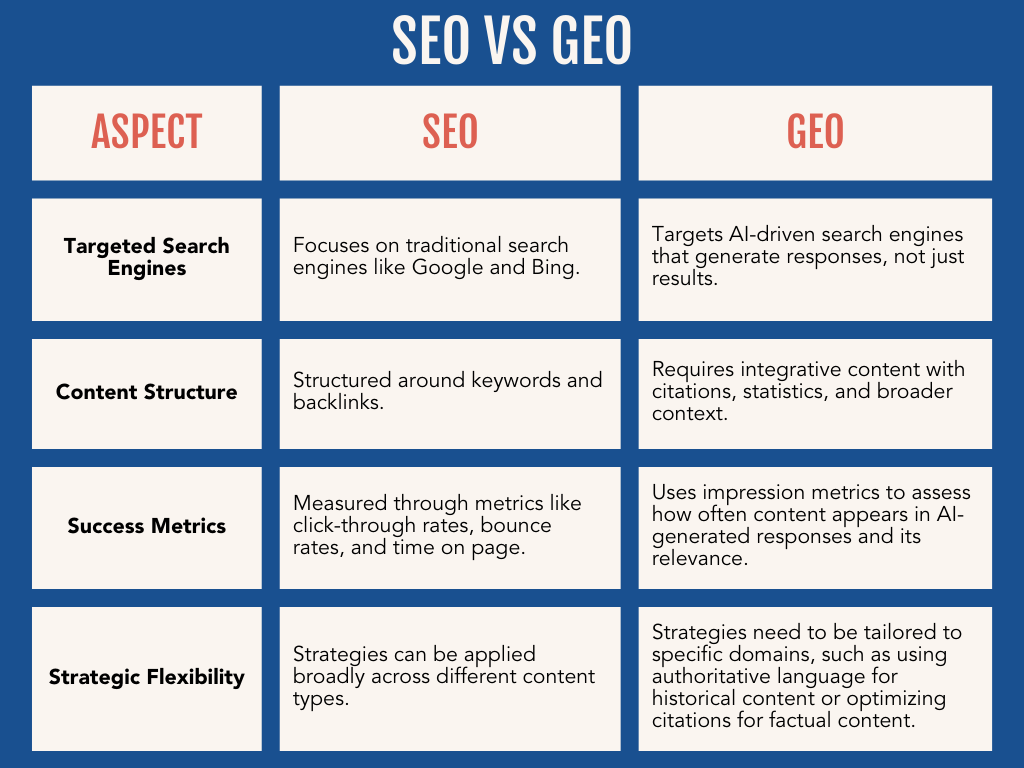
SEO is a widely recognized strategy that concentrates on enhancing websites to achieve higher rankings in traditional search engine results pages (SERPs). This optimization technique encompasses the utilization of targeted keywords, the development of top-notch content, and the establishment of backlinks, among other strategies. SEO primarily revolves around the way search engines like Google and Bing navigate and index websites.
Generative Engine Optimization (GEO)
On the flip side, GEO represents a newer concept that has surfaced in reaction to the ascent of AI-driven search engines, also known as generative engines.
These engines leverage artificial intelligence algorithms to produce responses and solutions to inquiries rather than just cataloging and ranking websites based on keywords. Essentially, GEO is an optimization tactic that concentrates on crafting content that not only captivates human readers but also strikes a chord with AI-driven search engines.
The Advent of GEO and Its Necessity
The GEO study that was conducted by students out of Princeton, Georgia Tech, The Allen Institute of AI, and IIT Delhi and published in November 2023 by Aggarwal, Murahari, Rajpurohit, Kalyan, Narasimhan, and Deshpande concluded with an impactful statement:
“Our analysis suggests that website owners should strive towards making domain-specific targeted adjustments to their websites for higher visibility. This statement highlights the importance of GEO in today’s digital landscape.”
The study concluded that through experimentation, the researchers were able to see a significant increase in their ability to influence the content that showed in the LLM:
“We propose several ways to optimize content for generative engines and demonstrate that these methods are capable of boosting source visibility by up to 40% in generative engine responses. Among other things, we find that including citations, quotations from relevant sources, and statistics can significantly boost source visibility.”
The most relevant part of this study is that the researchers studied nine key factors to understand what correlated with the likelihood of impacting the AI’s response.
These factors were:
- Unique Words
- Keyword Stuffing
- Easy-to-Understand
- Authoritative
- Technical Terms
- Fluency Optimization
- Cite Sources
- Quotation Addition
- Statistics Addition
The team then ran an analysis across each of these to understand which of these characteristics had the greatest impact on their results. It turned out that simple methods like keyword stuffing didn’t work well, but adding stats and quotations showed a significant performance improvement.
Empirical Evidence Supporting GEO
The team evaluated a variety of different Generative Engine Optimization methods, as outlined below, and compared them against a baseline in which no optimization took place. The results showed that some methods consistently outperform the baseline across all metrics:

The top-performing optimizations for the GEO efforts included:
- Quotation Additions
- Statistic Additions
- Fluency Optimization
- Cited Sources
- Technical Terms
- Authoritative Comms
The research presents a compelling case for GEO through rigorous evaluation.
A benchmark, termed GEO-BENCH, consisting of 10,000 diverse queries across multiple domains, serves as the foundation for the researchers’ systematic analysis.
The findings are striking and worth noting:
- GEO methods like the inclusion of citations, quotations from relevant sources, and statistics notably boosted source visibility by over 40% across various queries. This underscores the importance of content richness and credibility in optimizing for GEs.
All that said…
Sandbox SEO shared a great GEO critique, breaking down how some elements of the original methodology in the paper are not at the highest level of standards of most academic journals.
Specifically, the critic shares challenges like top five result restrictions, inconsistent prompt direction, low optimization visibility, and more.
The critique outlined by Sandbox is worth a read, as there are some great points in there. But from my perspective — the essence of what the original GEO paper summarizes as things worth doing are also the things worth doing to establish EEAT best practices.
What are these things that are worth doing? Here’s how it was described in the paper:
Intent-Specific Optimization
- Informational Queries: For queries seeking knowledge or information, adding citations, quotations, and statistics significantly boosts visibility. This approach aligns with the users’ need for credible, detailed answers, enhancing the content’s authority and trustworthiness.
- Navigational Queries: When users are looking to navigate to a specific website or page, the research found that fluency optimization and ensuring the content directly addresses the user’s destination can improve visibility in GE responses.
- Transactional Queries: For queries with a transactional intent, such as purchasing a product or subscribing to a service, including clear calls to action and optimizing content for clarity and persuasiveness were key strategies for increasing visibility.
Domain-Specific Optimization Efficacy
- Science and Technology: Technical term additions and authoritative style adjustments were particularly effective in these domains, likely due to the audience’s preference for precise and credible information.
- Arts and Humanities: In these areas, incorporating quotations and references to well-regarded sources helped increase content visibility, aligning with the audience’s appreciation for depth and cultural context.
- Business and Finance: The inclusion of statistics and data-driven insights significantly improved visibility, reflecting the audience’s need for factual, actionable information in decision-making processes.
How To Do Generative Engine Optimization
The key to successfully implementing GEO is understanding the processes of generative AI and leveraging this knowledge to create content that resonates with both humans and machines. Over the last few months, more and more data has started to come to light showcasing how this type of work can be executed with excellence and how it can translate into real outcomes for a business.
Here are some data backed strategies that we have seen first hand and found through data analysis to effectively influence the way a brand shows up in the LLMs. These are techniques that brands can incorporate in their content strategy today to generate LLM oriented results for months to come:
Research topics relevant to your customers:
At Foundation, we’ve been helping brands understand their current position in the market from the eyes of LLMs. In a world where AI Overviews and ChatGPT are influencing buying decisions just as much as word of mouth – we need to know what the LLMs are saying about us and our clients. Here’s a snapshot of what we’re seeing for brands like Lululemon in the LLMs:
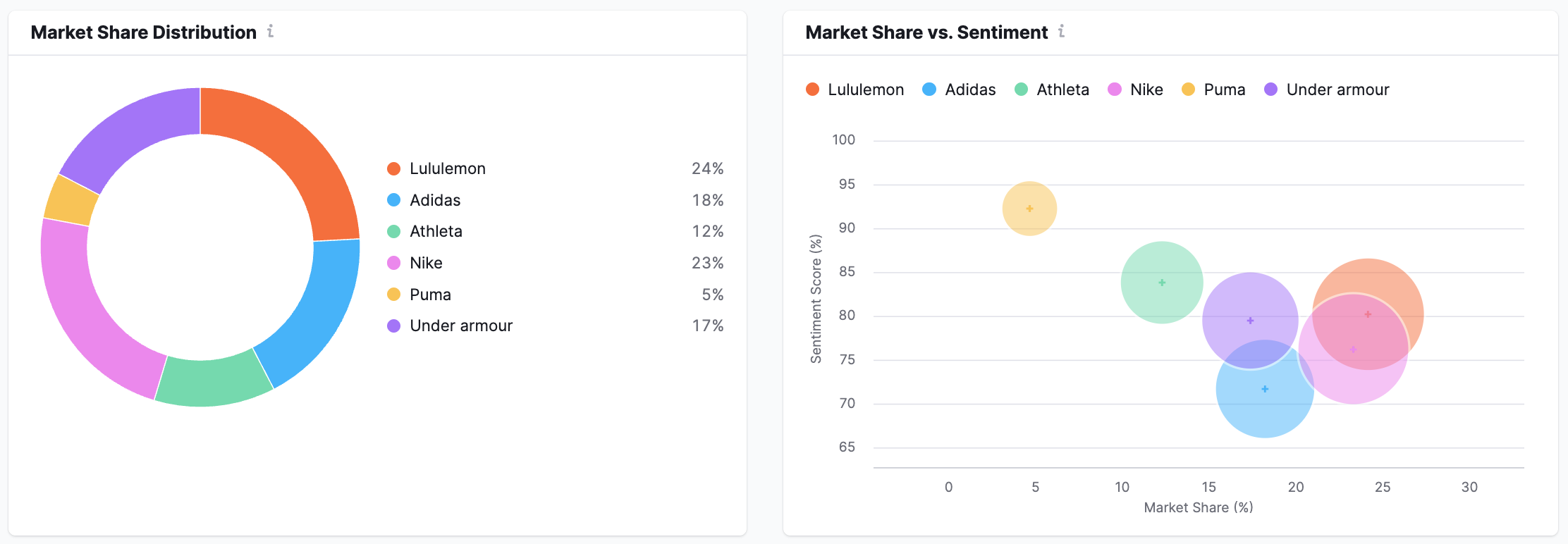
As you can see above, 24% of the dialogs within an LLM that are relevant to Lululemon is resulting in responses that include them. However, they’re in the middle of the pack when it comes to overall sentiment within the LLMs.
Our research conducted across Reddit Marketing initaitives with partners has provided early indicators that Reddit sentiment often correlates with LLM sentiment. As such, Generative Engine Optimization strategies that don’t include user generated content as a part of their mix are often times going to fall up short against those that do.
We recommend that brands use keyword research tools to identify what topics your target audience is interested in and the types of questions they are asking. Validate the volume of these questions usually asked in Google, and determine if there’s an intent relationship that would make you feel confident that your audience would ask it to an AI tool.
AI research tools like SEMrush’s AI toolkit provides insight inspired by the LLMs that get into strategic recommendations that organizations can take:
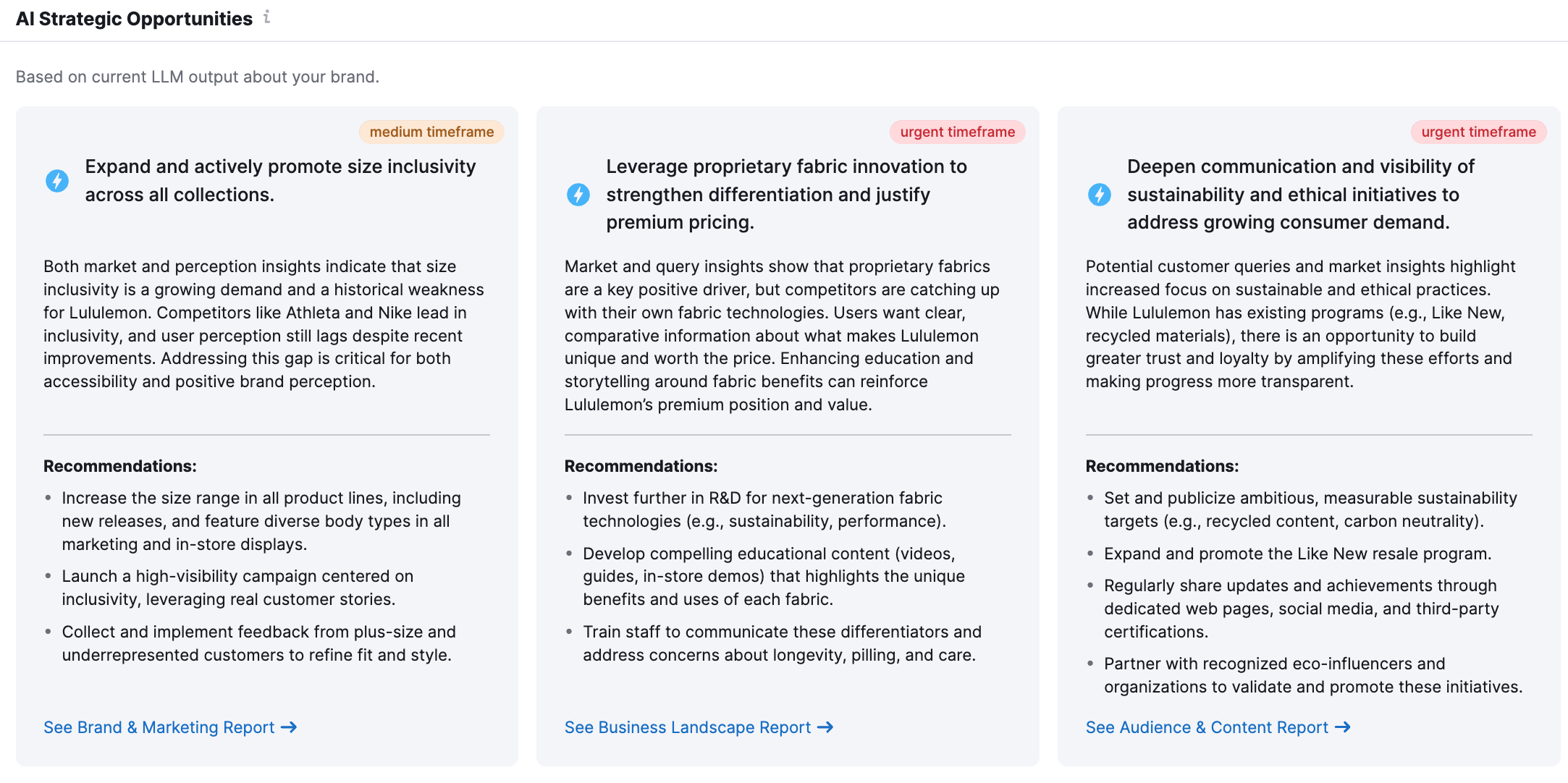
Create Query Intent Based Content At Scale
In a study conducted by Profound, it found that the most common cited asset were comparative listicles. Our tactical approach to creating what we call SaaS Money Pages aligns well with this finding around how brands can influence the LLMs and increase their likelihood of being cited. 32.5% of all sources cited by the LLMs were found to be comparative listicles followed closely by blog posts and opinion pieces at nearly 10%.
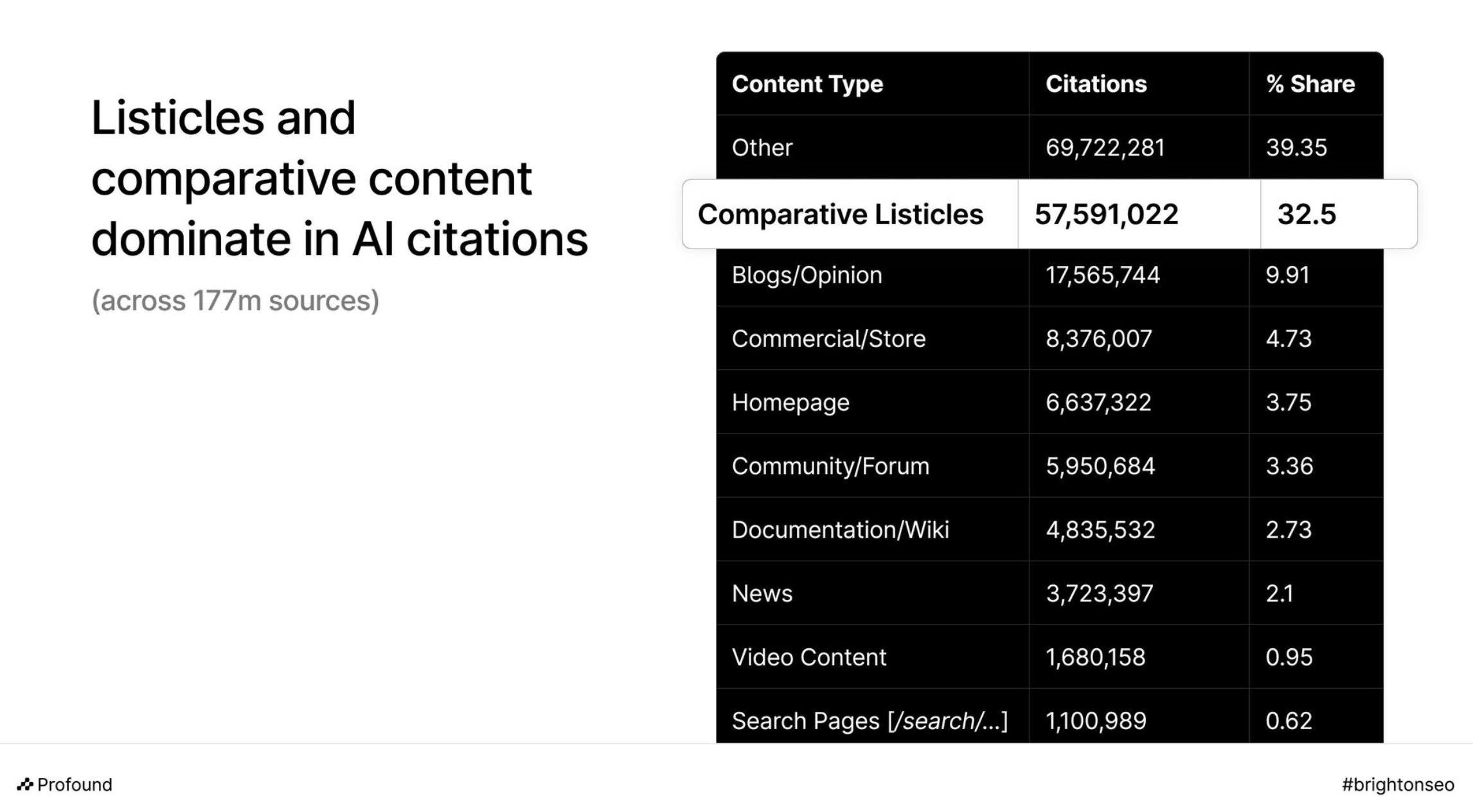
Using this insight, brands can see that one of the best ways to optimize their content for the LLMs is to develop and/or improve high-quality, relevant, and engaging content that addresses the identified topics and questions that align with queries people would ask an LLM. Comparison, alternatives, best, top, etc… Are all phrases that make up some of the common type of transactional queries that people would ask an LLM.
The optimization or creation efforts should be rooted in some of the ideas shared in the academic journal around GEO. The content should include reputable sources, quotes, and industry language and should be written in an authoritative manner, demonstrating trust and expertise.
Implement Digital PR Activities With Excellence
One of the most important factors of generative engine optimization is authority and expertise. As a way to increase your authority on a subject, you should become an expert on the subject. A tried and tested methodology for establishing authority is to execute digital PR activities that demonstrate that you or your brand is an expert or authority in the field or topic. Here’s a few types of digital PR activities that can influence the LLMs:
- Expert quotes: Being included in articles or essays talking about breaking news or trends
- Podcast features: Being interviewed by industry oriented podcasts can influence the LLMs
- Media features: If the media is writing about you with a positive spin, it can be a huge win for you
- Report features: If you’re quoted in reports or white papers it can further position you as an expert
Incorporate Structured Data
Utilize schema markup to provide context and structure for your content, making it easier for generative AI to understand and index.
Focus on user intent:
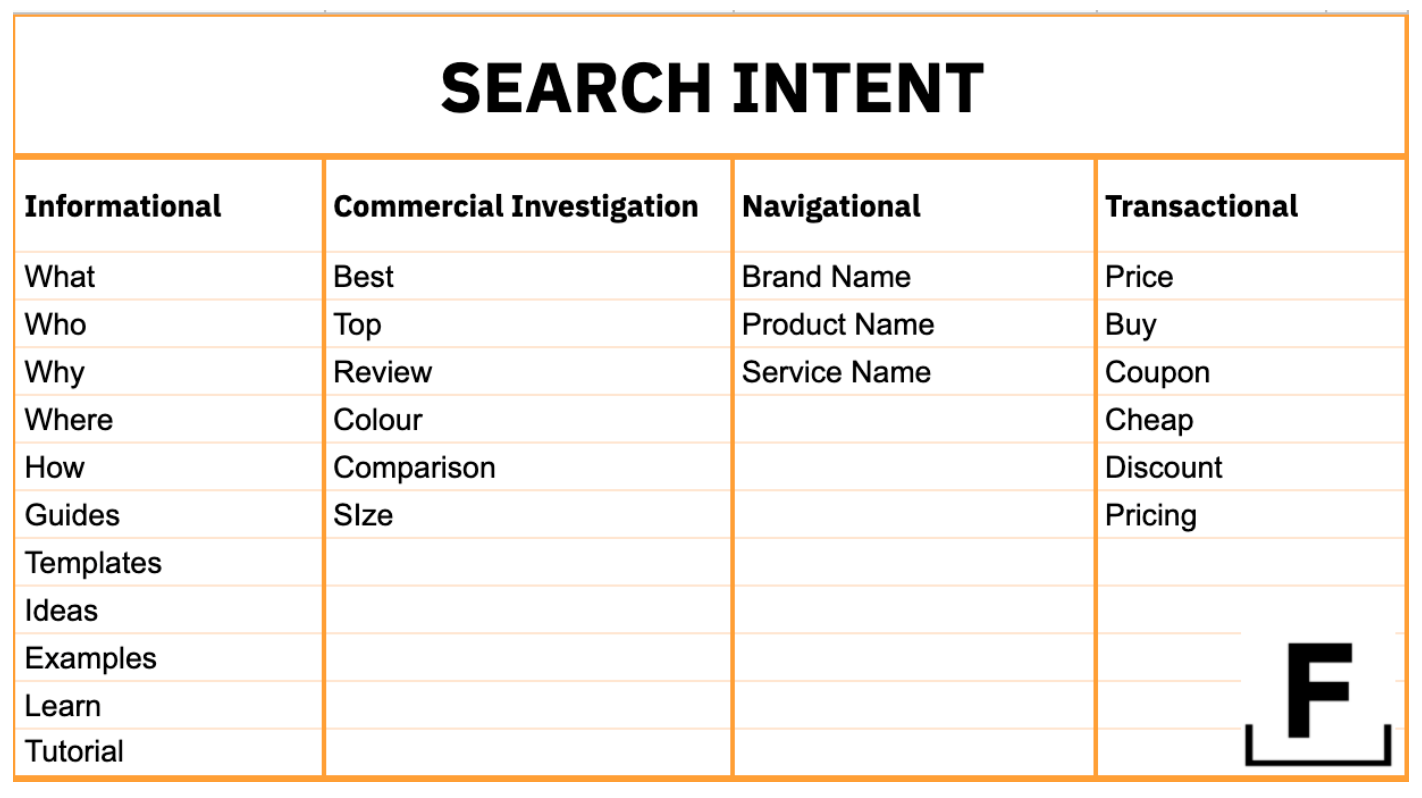
Keep in mind the purpose behind a user’s search query, and tailor your content to fulfill their intent. Unlike traditional search engines, which prioritize click-through behavior and backlink profiles, LLMs prioritize contextual relevance. That relevance is driven by how well your content matches the intent behind a query. In practice, that means covering a diverse mix of informational, investigational, navigational, and transactional intents vs just optimizing for one.
To succeed in GEO, content teams must cover across the primary search intent buckets:
Informational Queries
These are foundational to LLM engagement. Users are asking:
-
“What is [topic]?”
-
“Who invented [concept]?”
-
“Why is [thing] important?”
-
“How does [system] work?”
-
“Examples of [practice]”
-
“Learn [topic] step-by-step”
These queries are ideal for evergreen blog posts, FAQ pages, or long-form guides. They’re frequently used in LLM prompts and often feed directly into featured snippets and conversational answers.
Commercial Investigation Queries
These are decision-stage questions like:
-
“Best [tool] for [use case]”
-
“Top 10 [alternatives]”
-
“[Product A] vs [Product B]”
-
“Review of [solution]”
-
“Comparison of [platforms]”
Each of these deserves its own dedicated landing page or comparison post. These are critical for surfacing in LLM answers when users are trying to evaluate options—and they often directly precede purchase.
Navigational Queries
Branded search remains vital—even in generative environments. Users often enter prompts like:
-
“[Brand] pricing”
-
“[Tool] features”
-
“Login to [platform name]”
-
“[Company] help center”
If your brand doesn’t own these terms via structured pages and documentation, LLMs will either hallucinate the answer or pull from third-party aggregators. Create a clear digital footprint with indexable landing pages for every product, service, and support query.
Transactional Queries
These are bottom-funnel and purchase-driven:
-
“Buy [product] online”
-
“[Brand] coupon”
-
“Cheap [alternative]”
-
“Discount on [tool]”
-
“Pricing for [solution]”
Every one of these is a conversion opportunity—and a potential citation source for a model trying to recommend a product or summarize pricing. Dedicated sales pages, offers, and pricing breakdowns should be created to map to each of these terms.
Distribute your content:
The LLMs are training not just on content found in blog posts but also inside of communities like Reddit and Quora.
Distribute your content through these channels to maximize your ability to influence the stories sent back to relevant questions. A recent study from Profound revealed that across millions of citations that Reddit was the top sourced URL:
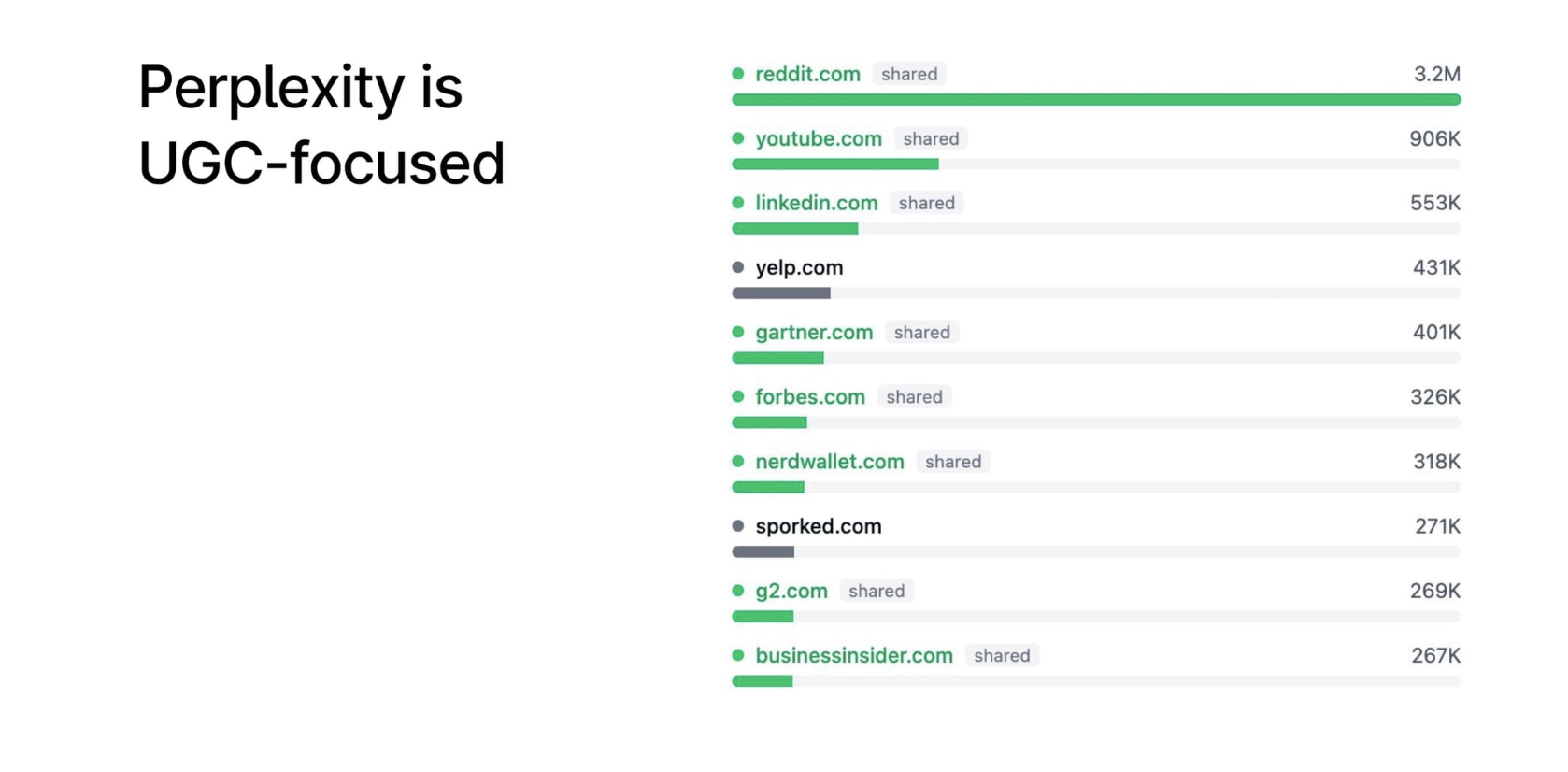
What does this mean?
It means Marketing on Reddit is becoming more and more of an opportunity for businesses looking to influence the LLMs. As one of the first Reddit Marketing Agencies we have been able to see the compounding impact of creating content in Reddit that shapes the sentiment amidst communities and see how that translates into the LLMs.
Embrace multimedia:
Diversify your content by incorporating visual and interactive elements like videos, infographics, and quizzes to engage both human readers and AI-driven search engines.
Leverage social media:
Share your content on social media platforms to increase its reach and engagement. Generative AI also uses signals from social media to rank and index content. We’re seeing LinkedIn Articles and Medium essays cited more than ever before in B2B oriented queries so building for these platforms can pay dividends long term.
Optimize your website’s AI readiness:
Use HubSpot’s AI Search Grader to evaluate how well your website content is optimized for AI-powered search engines. This free tool analyzes your website’s content quality, structure, and relevance to help identify areas for improvement. The AI Search Grader provides actionable insights on enhancing your content’s visibility and performance in AI-powered search results, ensuring your website stays competitive in the evolving search landscape. Regular assessment and optimization using such tools can help maintain your content’s effectiveness for traditional and AI search engines.
By implementing these strategies, you can effectively optimize your content for both human readers and AI-driven search engines, ensuring maximum reach and impact on the digital landscape.
Here’s my take:
GEO is more than a trend. It’s an evolution of how we think.
Will it forever be called GEO? I don’t know…
The name currently makes me think of Geography.
But much like how corner shops evolved into department stores and then into personalized online storefronts, GEO represents the next step in SEO’s waltz with technology.







